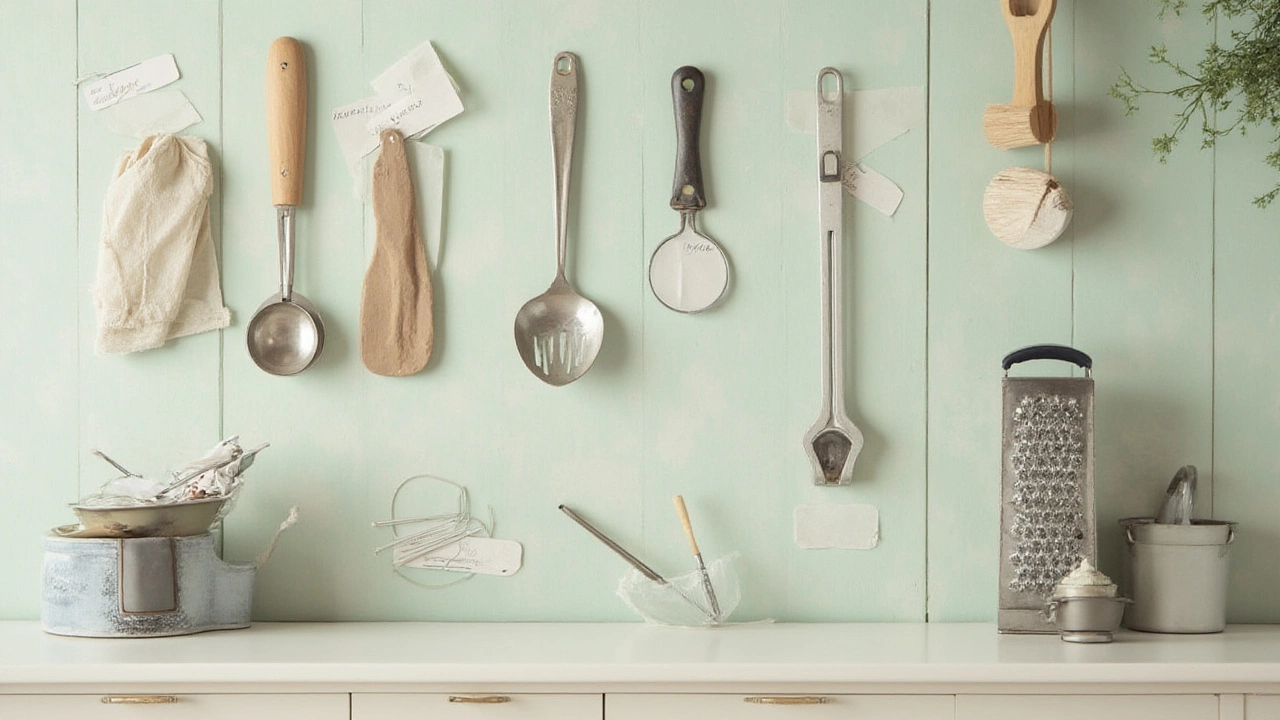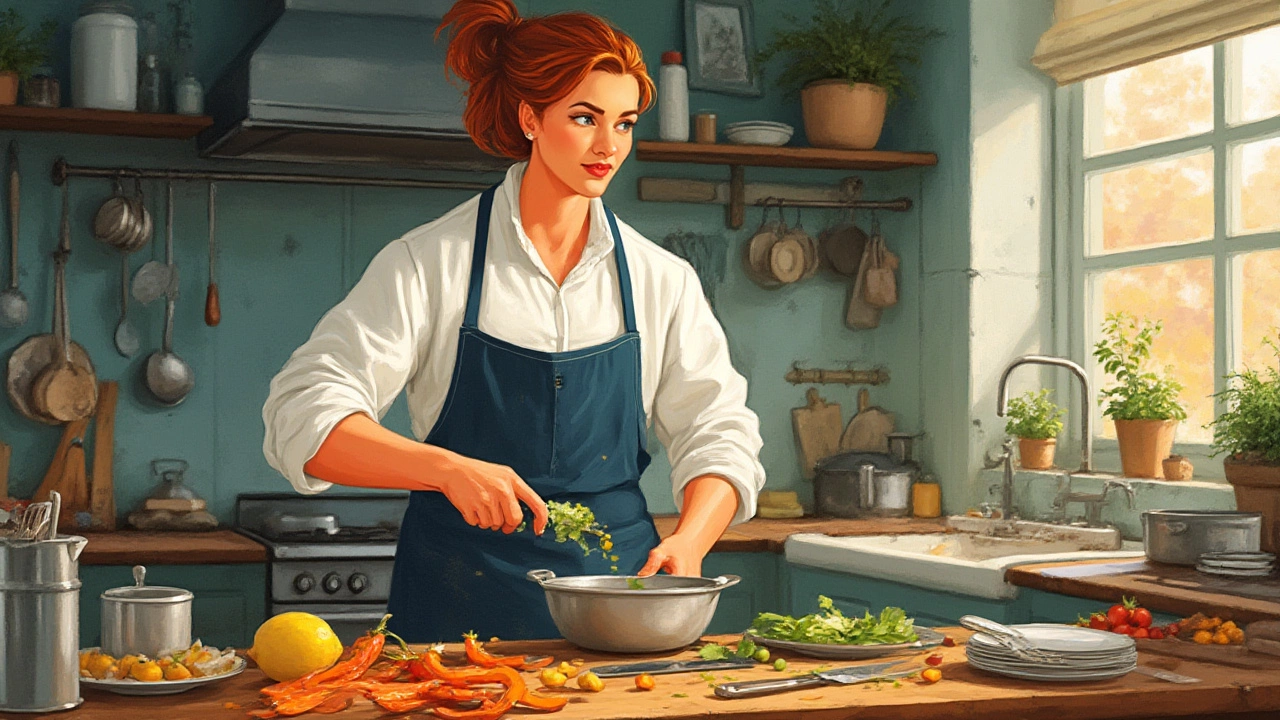Kitchen Utensils: Names, Uses, and Must-Know Facts for Every Home Cook
 Jul, 23 2025
Jul, 23 2025
Ever tried following a recipe and stalled because you ran into some mysterious tool called a "zester" or "skimmer"? My kids, Dorian and Selena, still giggle at the sight of my old avocado slicer. The truth is, the world of kitchen utensils is much bigger and weirder than most people expect. If you’ve never thought too deeply about it, you’ll be surprised at how much these everyday objects shape the way we cook, eat, and even live. Some utensils are ancient and steeped in tradition; others are bizarrely modern inventions designed for very specific kitchen quirks.
The Big Bucket: What Counts as a Kitchen Utensil?
When you hear "kitchen utensils", what pops into your head? Probably a spatula or maybe a wooden spoon, right? But the umbrella is much wider. Kitchen utensils cover every hand-held tool used in preparing, cooking, or serving food—it stretches from that basic butter knife tucked in your drawer, all the way to the odd gadgets that only show up when you host a fancy dinner (grapefruit spoons, anyone?). Officially, utensils differ from appliances (think blenders, ovens) and cookware (pots, pans). The word itself traces to the Latin "utensilia," meaning "things for use"—pretty straightforward for something you touch every day.
And boy, have the names stuck. In France, they’ll call a whisk a “fouet,” in Japan, a fish scaler might translate to “sakana no urokotori.” Nearly every culture carves a small part of their identity into kitchen tools. For folks who take pride in hosting, mastering utensil names is like learning a new alphabet. It also saves you time—no more digging around for “that thingy with the holes,” when you can just say “colander.”
The variety goes well beyond basics. Most kitchens, according to a 2023 consumer report, have at least 30 different utensils on hand—spanning from prep tools (peelers, graters), to cooking tools (turners, tongs), to serving pieces (ladles, pie servers). Some utensils, like chopsticks, are both cultural icons and practical tools.
If you think you can get away with just a spoon and knife, you’ll end up improvising and, eventually, making a mess. Trust me—I’ve tried pouring cake batter with a drinking glass. Don’t. The right utensil saves time, energy, and in many cases, your sanity.
Common Names and Their Hidden Histories
Here’s where things get fun. Some kitchen utensils have names that make perfect sense—measuring cups, for instance, do what they say. But dig a little deeper and these objects come with stories. The word “spatula” hops from the Latin "spatha," meaning broad sword. “Mandoline” comes from French, where the swift movement of slicing veggies was thought to resemble playing—you guessed it—a mandolin. The “zester” only became common after the late ‘80s, when home cooks started adding citrus zest to sweet and savory dishes.
And then there are the names that stump even seasoned cooks: “Spurtle” (a Scottish stirring stick for porridge), “rondel” (a small round knife), “chinois” (a fine-mesh conical strainer). The table below sums up a few common—and not-so-common—names and what they do:
| Name | Fun Fact |
|---|---|
| Whisk | Were bundled twigs until the 19th century |
| Slotted Spoon | Perfect for fishing objects out of liquids |
| Fish Turner | Designed wider and thinner for flipping fillets |
| Tongs | First used in Ancient Egypt for grabbing hot embers |
| Mezzaluna | Italian for "half-moon"; chops herbs smoothly |
| Zester | Common in modern baking but rare before the 1980s |
| Microplane | Invented from woodworking tools in the 1990s |
| Ricer | Presses potatoes for super-smooth mash |
| Mortar & Pestle | One of the earliest kitchen tools from 35,000 B.C. |
| Spurtle | Traditional Scottish stirrer for porridge |
Some utensils switch up their names based on region. For example, what Americans call a “can opener,” Brits will sometimes call a “tin opener.” So, if you’ve ever felt out of place reading a recipe from overseas, you’re not alone. Even the most straightforward utensils come with a fair amount of confusion—there are almost 100 different names for kitchen knives alone, each describing size, shape, or use. Even a basic spoon splits into soup spoon, dessert spoon, teaspoon, and tablespoon.

Essential Utensils Every Kitchen Needs (and Why)
If you’re starting out, or if you’re outfitting a kitchen for your kids moving to college, choosing the right utensils sounds overwhelming. The secret: you don’t need everything, just the right things. A study done by a Dutch home goods chain in 2023 found that most people really only use about 6-8 utensils every day. These are the MVPs:
- Knife (Chef’s knife and paring knife): Chops, slices, and peels. Don’t cheap out here if you can avoid it.
- Cutting Board: Protects your counters and keeps things sanitary.
- Wooden Spoon: Perfect for stirring hot soups or sauces without scratching pans.
- Ladle: You’ll need it for soups, stews, or anything you want to scoop.
- Spatula (or turner): Flips pancakes, eggs, burgers—the works.
- Tongs: Grab, flip, or serve—nobody wants to burn their fingers.
- Peeler: Making salads is faster and safer when you have one of these.
- Measuring Cups and Spoons: Even the fanciest chefs measure tricky ingredients.
- Can Opener: For all those tins you forgot you bought.
- Sieve or Colander: Draining pasta or rinsing berries works best with these.
I still remember buying my first garlic press. Game changer. Suddenly, I could add extra flavor without sticky hands. Don’t underestimate the little gadgets that solve everyday annoyances: an ice cream scoop, a pizza cutter, or a microplane for quickly grating cheese or zesting lemons. When you’re cooking with kids, let them handle plastic or silicone utensils—they’re safer, and Dorian can happily mash potatoes for hours without breaking a thing.
Some people swear by specialized gadgets—avocado slicers, cherry pitters, rice molds. These are nice-to-haves if space and budget allow, but don’t let the kitchen aisle tempt you too much. The right basic utensils do almost everything a specialty tool can do, just with some cleverness.
Pro tip: When something in your kitchen drawer keeps popping up but you never use it, that’s your cue to let it go. Only keep what fits your actual cooking habits.
Material Matters: Choosing the Best Type for Every Use
So you’ve got your list of must-have utensils. Here’s the next thing people forget: what they’re made from can totally change how well they work. Stainless steel is king for anything that needs strength (like tongs or whisks), while wood won’t scratch up your pans. Silicone is now everywhere—heat-resistant, dishwasher-safe, and gentle on non-stick coatings, which is especially important if you’re like me and can’t stand scraping pans.
Each choice has a downside. Metal can get hot and scratch sensitive cookware, wood can crack if not cared for, and some cheap plastics can melt. A 2022 food safety report claimed 12% of house fires started with plastic utensils left too close to heat. Yikes. The safest all-rounders for most kitchens these days are silicone or sturdy wood. Bonus: modern silicones work in the oven up to 500°F, so you’ll rarely melt or warp anything.
Bamboo utensils are on the rise as people want more sustainable options. They’re naturally antibacterial and compostable. Glass might sound weird, but there are glass measuring cups and even glass butter knives on the market, mostly for their non-reactive nature—no weird flavors leaching into your food.
If you’re shopping, check for ergonomic handles that stay cool, and avoid bargain-bin plastics that feel flimsy. I once snapped a cheap spatula right when flipping pancakes for my kids; not a fun way to start Sunday brunch.
Dishwasher-safe utensils save time, but hand-washing certain tools (especially wooden or high-end knives) keeps them performing better, longer. Store everything dry and neatly organized—utensil caddies or drawer trays beat the classic "junk drawer" mess. Kids love helping out if you make utensils easy to grab and sort.

Tips and Surprising Facts: Level Up Your Kitchen Know-How
You probably didn’t realize, but the kitchen utensil world is packed with trivia. For instance, the spaghetti measurer—a tool to determine the amount of dry pasta for one, two, three, or four people—was invented in Italy in the 1980s. Early ice cream scoops could double as melon ballers in a pinch. Did you know there are fish bone tweezers designed just for removing tiny bones? Or that there’s a utensil called a "gravy separator" which can save your homemade sauce from being greasy?
Efficiency matters: group your most-used utensils in a countertop crock, not buried in a far-away drawer. If you love baking, consider investing in a dough scraper (the kind that gets every last bit of dough and cleans your counter fast). Tired of stuck-on cheese? A microplane can zest citrus and grate hard cheese like Parmesan—without chunks getting trapped.
If you ever go traveling, check out local markets for specialty utensils. Japanese kitchens, for example, have dedicated chopstick rests and daikon graters. French cooks often use a “bouquet garni” infuser, a mesh ball for flavoring stews. When outdoor grilling, long-handled tongs that lock shut are the secret weapon for keeping hands away from flames.
A quick trick: For sticky foods (peanut butter, honey), dip your spoon or Measuring Cup in warm water or a thin layer of oil first—everything slides right out. For peeling soft-boiled eggs, use a teaspoon to slide between shell and white—works so much better than rough peeling. And if you ever wonder whether you really need a “zester,” just compare the texture of lemon zest grated with a microplane vs. a knife; it’s a night-and-day difference in flavor burst and appearance.
The biggest myth? That you need dozens of gadgets to cook well. Truth is, chefs everywhere rely mostly on smart technique and a handful of trusty tools. Next time you walk down the kitchen appliance aisle, remember: the fancy stuff is fun, but the basics have stood the test of time for a reason. That’s why the humble kitchen utensil—by any name—makes all the difference.